The CUbit Update - February 2022
Featured Story
The CUbit Quantum Initiative today welcomed the first four strategic industry allies to formally join as CUbit Innovation Partners: Atom Computing, ColdQuanta, Meadowlark Optics and SPIE, the international society for optics and photonics.
Explore additional coverage below:
- More join CU Boulder CUbit Quantum Initiative (Inside Quantum Technology)
- CU Boulder adds four industry partners to CUbit (HPC Wire)
- Atom Computing, ColdQuanta, Meadowlark Optics and SPIE Join CU Boulder’s CUbit Quantum Initiative (Quantum Computing Report)
- Industry partners join CUbit Quantum Initiative (BizWest)
Top Quantum Stories
State of Colorado and Government of Finland create new quantum partnerships
Colorado Governor Jared Polis and delegates from Finland recently signed an MOU to create collaborative partnership opportunities focused on foreign direct investment and research and development projects in quantum science, as well as company expansion opportunities and exchanges.
JILA atomic clocks measure Einstein’s general relativity at millimeter scale
New experiments at JILA, recently published in Nature, allow physicists to study time dilation at the smallest scale ever, suggesting how to make atomic clocks 50 times more precise than today’s best designs—and offering a route to perhaps revealing how relativity and gravity interact with quantum mechanics.
ColdQuanta CEO discusses commercialization and academia with Scott Amyx
The business podcast "Innovating with Scott Amyx" recently interviewed ColdQuanta CEO Scott Faris about the process of commercializing the company's pioneering cold atom quantum technology, products and services—which grew out of research originally conducted at CU Boulder.
Two physicists win prestigious NSF CAREER Awards
Bethany Wilcox, assistant professor of physics, has won $745K in support of a project to develop tools that can be used to improve teaching of quantum mechanics. Additionally, Assistant Professor Andrew Lucas won $500K in support of a project to predict new kinds of fluids that can exist in nature.





